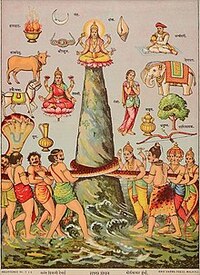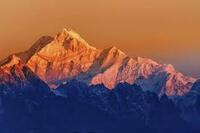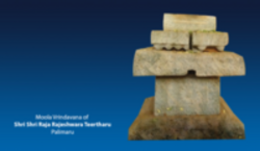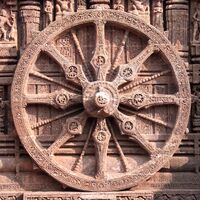Mangalaashtakam Verse 5:
श्रीमॆरुर्हिमवांश्च मन्दरगिरिः कैलासशैलस्तथा
माहॆन्द्रॊ मलयश्च विन्ध्यनिषदौ सिंहस्तथा रैवतः
सह्याद्रिर्वरगन्धमादनगिरिर्मैनाकगॊमन्तकौ
इत्याद्या भुवि भूधराश्च सततं कुर्वन्तु नॊ मन्गलम् ॥ ५ ॥
ಶ್ರೀಮೇರುರ್ಹಿಮವಾಂಶ್ಚ ಮನ್ದರಗಿರಿಃ ಕೈಲಾಸಶೈಲಸ್ತಥಾ
ಮಾಹೇನ್ದ್ರೋ ಮಲಯಶ್ಚ ವಿನ್ಧ್ಯನಿಷದೌ ಸಿಂಹಸ್ತಥಾ ರೈವತಃ
ಸಹ್ಯಾದ್ರಿರ್ವರಗನ್ಧಮಾದನಗಿರಿರ್ಮೈನಾಕಗೋಮನ್ತಕೌ
ಇತ್ಯಾದ್ಯಾ ಭುವಿ ಭೂಧರಾಶ್ಚ ಸತತಂ ಕುರ್ವನ್ತು ನೋ ಮನ್ಗಲಮ್ || ೫ ||
shrImErurhimavaaMshcha mandaragiriH kailaasashailastathaa
maahEndrO malayashcha vindhyaniShadou siMhastathaa raivataH
sahyaadrirvaragandhamaadanagirirmainaakagOmantakou
ityaadyaa bhuvi bhUdharaashcha satataM kurvantu nO mangalam || 5 ||
Meaning:
May the following mountains and hills on Earth, always bless us with auspiciousness:
Meru
Himavaan (Himalaya)
Mandara
Kailaasa
Maahendra
Malaya
Vindhya
Nishada
Simha
Raivata
Sahyaadri
Gandhamaadana
Mainaaka
Gomantaka
The Mangalaashtaka mentions 14 mountains / large hills. There are two points to note. Each mountain or hill has an abhimaani devata (patron deity) associated with it. This verse is focused on the abhimaani devata and not on the physical structure. This is because the structure is inanimate and cannot bless or harm us; it is the abhimaani devata who has the power to do this. The second point to note is that not all the mountains and hills mentioned in this verse are visible to human eyes; several of them are visible only to gyanis and celestials. Some scholars believe that six of mountains mentioned here – Meru, Himavaan, Mandhara, Kailaasa, Nishada and Gandhamaadana – are all different peaks of Himalaya. This is similar to Ganga having several names like Alakananda, Mandaakini, Nandaakini and Bhaageerathi. Incidentally, mountains are home to many varieties of plants, vegetations and animals. They also have many types of minerals in them.
Meru: This mountain is described in many puraaNas and spiritual works. It is a mystical mountain not visible to humans. It is made up of gold. That is why it is also known as Sri Meru or Sumeru. According to puraaNas, it is in the northern tip of Jamboo dveepa. It is so tall that even the sun goes around it and not over it. All the planets are said to rotate around this super mountain.
It is said to be the abode of celestials. Chatumukha’s house is situated in a portion of Meru called Vyjayanta. The ashramas of the saptarishis and that of Vedavyaasa are all said to be in Meru. The Anantaasana abode of Lord Vishnu is also here. All the rishis, gandharvas, Naarada, Tumburu and other sages assemble in the Meru during holy days. Shukraachaarya, the preceptor of daityas, also resides here. Shiva and Paarvati sport in the park called Karnikaara vana. All of these are visible only to gyaanis and celestials. Ganga descended to Earth from one of its peaks. The abhimaani devata of this mountain (meru deva) is a courtier in Kubera’s court. His daughter, Meru devi, married Naabhi and gave birth to Lord Rushabha. Meru is known for its peaks. The Lord has his vibhooti roopa (special presence) in its peaks. That is why Krishna says in the Gita “mEruH shikhariNaamaham” (I am Meru amongst mountains having peaks). It is said to be full of caves.
Himavaan (Himalaya): This mountain needs no elaboration because even school going children know that it is the northern tip of India. But not many know that the abhimaani devata for this mountain is Parvata-raaja. He too is a courtier in Kubera’s court. He is the father of Mainaaka and Parvati. This mountain has many famous peaks like Everest, Kailas, Kanchana junga etc. The Pandavas were born here, in a location called PandukEshavar. Lord Veda Vyaasa has another ashrama here, as does Naarada. Ganga and Yamuna take their birth in this mountain. This is where Lord Krishna pretended to do tapas towards Shiva in order to obtain a son (Pradyumna). Nahusha, in the form of a Python, snagged Bhima in a forest on this mountain. This is also the abode of Nara-Naaraayana rishis. Famous shrines like Badari, Kedaar, Maanasa sarovar are all in this mountain.
Mandhara: This is a mystical mountain not visible to ordinary beings; however, some scholars consider it to be a a peak of Himalaya that is not easily accessible. It is said to be shaped like a Top. When the devatas and asuras decided to churn the ocean, they used this mountain as the churning instrument (Kadagolu). It is next to Kailas. It is said to be the home of Yakshas and Rakshasas. Its abhimaani devata is also a courtier in Kubera’s court.

Kailaasa: This peak is well known and documented in spiritual as well as non spiritual works. However, they say that only a portion of this peak is visible to humans. It is considered to be the abode of Lord Shiva and said to be shining as bright as silver. It is said that Bhageeratha performed his penance for Shiva in this mountain. The Ashrama of Veda-Vyaasa is close by. In Madhva Vijaya it is said that Acharya Madhva visited Veda-Vyaasa in this ashrama. The pond seen by Bhima when he went to pick up the Sougandhika flower is close by. Many Yakshas, Raakshasaas, Gandharvas and Apsaras reside here. The abhimaani devata for this mountain is also a courtier in Kubera’s court.
Maahendra: This hill is in the northern tip part of the Eastern ghats and is located in Orissa. It is mentioned in Mahabharata, Raamayana and Puraanas. Lord Parashuraama is said to reside in this hill even to this day. It is on this hill that Arjuna did his tapas towards Shiva in order to obtain Paashupataastra and met Shiva in the form of a hunter. Incidentally, there is another hill with the same name in Kerala.
Malaya: This is a part of the Western ghats, located in Kerala.. The terms ‘malayaala’, ‘malabaar’ all originated from this term. It is said to be full of sandalwood trees. One of the names for sandalwood in Sanskrit is Malayaja (born in Malaya). It is said that Hanumanta and other apes visited this hill when looking for Sita. The abhimaani devata for this mountain is also a courtier in Kubera’s court.
Vindhya: It is in the central part of India, dividing India into North and South India. It has the sannidhaana (special presence) of Durga. That is why one of the names of Durga is Vindhyavaasini. Some scholars say that in ancient times, the land south of Vindhyas was full of forests, with little to no human presence; all of civilization was to the North. This gradually changed with time and with the advent of the three Acharyas (Shankara, Raamanuja and Madhva), South India acquired special spiritual and religious status. As stated earlier (while describing Agastya), when this mountain started growing taller in order to compete with Meru, Agastya tricked it into stooping low (in order to allow him passage) and staying in that position for eternity. The abhimaani devata for this mountain is also a courtier in Kubera’s court.
Nishada, Simha, Raivata, Sahyaadri, Gandhamaadana, Mainaaka, Gomantaka: According to scholars, Nishada mountain is to the West of Gandhamaadana mountain and to the North of kabool river. The modern name for this is Hindu-kush mountain. Nishada kingdom, ruled by Nala, was at the foot of this mountain.
Simha refers to Simhachala. It is near Vishakapatnam (aka Vizag). A famous Narasimha temple is located here. The mountain derives its name from this deity. There is also mention in some puraaNas of a simhaapura kingdom in North India, that was full of hills and mountains. It is possible that those mountains had the name of Simhaachala.
Raivata is in Gujarat, near Junaagad. The modern name is “Girnaar”. It was the favorite sporting ground of Yadavas. Several puraaNas mention Krishna’s visits to this mountain.
Sahyaadri refers to the portion of Western ghats that is in Karnataka (the portion in Kerala is called Malayaachala). It is located near Shimoga, Chikkamagalur and the coastal districts. It is said that Hanumanta and other apes visited this mountain while searching for Sita. Some of the famous landmarks associated with this are Aagumbe (waterfalls), Chaarmaadi ghat, kutajaadri, kumaaraadri and kuduremukh (known for mining). Scientists believe this mountain abounds with many rare flora and fauna.
Gandhamaadana is said to be a part of the Himalayas.. It is to the North of Himachal and closer to Badari. This is the mountain that Hanuman carried to the battlefield to revive Lakshmana. When Bheema was a baby he fell to the ground from his mother’s lap. Nothing happened to him but the rock on which he fell developed multiple fractures, earning it the name “shata shringa”. All of that happened in this mountain. It is a storehouse of rare plants and herbs with miraculous medicinal properties. Nara-naaraayana have an ashrama here. It is said to be the home of many Yakshas. Pandavas were born here and also spent some time here during their 12 years of vanavaasa (exile); the famous meeting between Hanuman and Bheema, graphically described in the Vaayu stuti, is said to have occurred here. There is a valley with exquisite and rare flowers. This was visited by Bheema when he came looking Sougandhika flower. The abhimaani devata for this mountain is also a courtier in Kubera’s court.
The abhimaani devata for Mainaaka hill is the brother of Paarvati and the son of Parvata raaja. There was a time when mountains had wings and would move about at will, causing a lot of havoc to humans and animals. To stop this, Indra cut off their wings with his vajraayudha (thunderbolt). At the time, Vaayu devaru hid Mainaka within the ocean, thereby saving his wings. When Hanuman jumped from Mahendra parvata to Lanka, Mainaka came from the bottom of the ocean to provide him rest. This was his way of showing gratitude to Vaayu. However, Hanuman did not accept his offer; he affectionately embraced Mainaka and continued on his way. This incident is described in Sundara kanda nirnaya of MBTN. Some people say that this is nothing but Shivalik hills at the foot of the Himalayas
Gomanta or gomaantaka parvata is part of the western ghats and is found in Goa. When Jaraasandha attacked Mathura, Krishna and Balarama came to this mountain to draw him away from Mathura. When Jaraasandha ordered the entire mountain to be burnt down in order to kill Krishna and Balarama, they jumped from the top of the mountain to the ground. The force of their jump cracked open Earth’s shell, forcing water to gush forth and put out the fire lit by Jaraasandha.
In summary, Sri Raja Rajeshwara Yati has described 14 mountains in this mangalaashtaka. Scientists and biologists also ask us to respect these mountains and hills for the sake of the flora and fauna in them, whereas religious works ask us to respect them for the sake of their abhimaani devatas.



